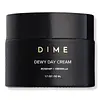What's inside
What's inside
 Key Ingredients
Key Ingredients

 Benefits
Benefits

 Concerns
Concerns

 Ingredients Side-by-side
Ingredients Side-by-side

Water
Skin ConditioningEthylhexyl Olivate
Skin ConditioningCetearyl Alcohol
EmollientGlycerin
HumectantIsononyl Isononanoate
EmollientPentylene Glycol
Skin ConditioningGlyceryl Stearate
Emollient1,2-Hexanediol
Skin ConditioningSqualane
EmollientVitis Vinifera Seed Oil
EmollientCaprylic/Capric Triglyceride
MaskingSodium Stearoyl Lactylate
EmulsifyingHydroxyacetophenone
AntioxidantOlea Europaea Fruit Unsaponifiables
AntioxidantXanthan Gum
EmulsifyingBehenyl Alcohol
EmollientCarbomer
Emulsion StabilisingRosa Moschata Seed Oil
EmollientLinoleic Acid
CleansingPhospholipids
Skin ConditioningPhytosterols
Skin ConditioningTetrasodium Glutamate Diacetate
Betaine
HumectantChamomilla Recutita Flower Extract
MaskingCeramide NP
Skin ConditioningSodium Hyaluronate
HumectantGlycolipids
Skin ConditioningTremella Fuciformis Sporocarp Extract
AntioxidantGlycine Max Seed Extract
Skin ConditioningAloe Barbadensis Leaf Juice
Skin ConditioningWater, Ethylhexyl Olivate, Cetearyl Alcohol, Glycerin, Isononyl Isononanoate, Pentylene Glycol, Glyceryl Stearate, 1,2-Hexanediol, Squalane, Vitis Vinifera Seed Oil, Caprylic/Capric Triglyceride, Sodium Stearoyl Lactylate, Hydroxyacetophenone, Olea Europaea Fruit Unsaponifiables, Xanthan Gum, Behenyl Alcohol, Carbomer, Rosa Moschata Seed Oil, Linoleic Acid, Phospholipids, Phytosterols, Tetrasodium Glutamate Diacetate, Betaine, Chamomilla Recutita Flower Extract, Ceramide NP, Sodium Hyaluronate, Glycolipids, Tremella Fuciformis Sporocarp Extract, Glycine Max Seed Extract, Aloe Barbadensis Leaf Juice
Water
Skin ConditioningC13-15 Alkane
SolventButylene Glycol
HumectantC15-19 Alkane
SolventCaprylic/Capric Triglyceride
MaskingGlycerin
HumectantTrioctyldodecyl Citrate
EmollientPolyglyceryl-3 Polyricinoleate
EmulsifyingPolyglyceryl-4 Diisostearate/Polyhydroxystearate/Sebacate
EmulsifyingIsosorbide Dicaprylate
Skin ConditioningSynthetic Beeswax
Emulsion StabilisingDisteardimonium Hectorite
StabilisingPanthenol
Skin ConditioningTocopherol
AntioxidantTocopheryl Acetate
AntioxidantPalmitoyl Tripeptide-8
Skin ConditioningPalmitoyl Tetrapeptide-10
Skin ConditioningZingiber Officinale Root Extract
MaskingAstrocaryum Murumuru Seed Butter
EmollientPolyglutamic Acid
Skin ConditioningSodium Hyaluronate
HumectantHydrolyzed Glycosaminoglycans
HumectantBisabolol
MaskingTremella Fuciformis Polysaccharide
Emulsion StabilisingCeramide NP
Skin ConditioningHyaluronic Acid
HumectantHydrolyzed Hyaluronic Acid
HumectantCaprylhydroxamic Acid
Dextran
Trisodium Ethylenediamine Disuccinate
Phenoxyethanol
PreservativeEthylhexylglycerin
Skin ConditioningCitric Acid
BufferingSodium Chloride
MaskingBenzyl Alcohol
PerfumingWater, C13-15 Alkane, Butylene Glycol, C15-19 Alkane, Caprylic/Capric Triglyceride, Glycerin, Trioctyldodecyl Citrate, Polyglyceryl-3 Polyricinoleate, Polyglyceryl-4 Diisostearate/Polyhydroxystearate/Sebacate, Isosorbide Dicaprylate, Synthetic Beeswax, Disteardimonium Hectorite, Panthenol, Tocopherol, Tocopheryl Acetate, Palmitoyl Tripeptide-8, Palmitoyl Tetrapeptide-10, Zingiber Officinale Root Extract, Astrocaryum Murumuru Seed Butter, Polyglutamic Acid, Sodium Hyaluronate, Hydrolyzed Glycosaminoglycans, Bisabolol, Tremella Fuciformis Polysaccharide, Ceramide NP, Hyaluronic Acid, Hydrolyzed Hyaluronic Acid, Caprylhydroxamic Acid, Dextran, Trisodium Ethylenediamine Disuccinate, Phenoxyethanol, Ethylhexylglycerin, Citric Acid, Sodium Chloride, Benzyl Alcohol
 Reviews
Reviews

Ingredients Explained
These ingredients are found in both products.
Ingredients higher up in an ingredient list are typically present in a larger amount.
This ingredient is an emollient, solvent, and texture enhancer. It is considered a skin-softener by helping the skin prevent moisture loss.
It helps thicken a product's formula and makes it easier to spread by dissolving clumping compounds.
Caprylic Triglyceride is made by combining glycerin with coconut oil, forming a clear liquid.
While there is an assumption Caprylic Triglyceride can clog pores due to it being derived from coconut oil, there is no research supporting this.
Learn more about Caprylic/Capric TriglycerideCeramide NP is a type of ceramide.
Ceramides are intercellular lipids naturally found in our skin that bonds dead skin cells together to create a barrier. They are known for their ability to hold water and thus are a great ingredient for dry skin.
Ceramides are an important building block for our skin barrier. A stronger barrier helps the skin look more firm and hydrated. By bolstering the skin ceramides act as a barrier against irritating ingredients. This can help with inflammation as well.
If you would like to eat ceramides, sweet potatoes contain a small amount.
Read more about other common types of ceramides here:
Ceramide AP
Ceramide EOP
Glycerin is already naturally found in your skin. It helps moisturize and protect your skin.
A study from 2016 found glycerin to be more effective as a humectant than AHAs and hyaluronic acid.
As a humectant, it helps the skin stay hydrated by pulling moisture to your skin. The low molecular weight of glycerin allows it to pull moisture into the deeper layers of your skin.
Hydrated skin improves your skin barrier; Your skin barrier helps protect against irritants and bacteria.
Glycerin has also been found to have antimicrobial and antiviral properties. Due to these properties, glycerin is often used in wound and burn treatments.
In cosmetics, glycerin is usually derived from plants such as soybean or palm. However, it can also be sourced from animals, such as tallow or animal fat.
This ingredient is organic, colorless, odorless, and non-toxic.
Glycerin is the name for this ingredient in American English. British English uses Glycerol/Glycerine.
Learn more about GlycerinSodium Hyaluronate is hyaluronic acid's salt form. It is commonly derived from the sodium salt of hyaluronic acid.
Like hyaluronic acid, it is great at holding water and acts as a humectant. This makes it a great skin hydrating ingredient.
Sodium Hyaluronate is naturally occurring in our bodies and is mostly found in eye fluid and joints.
These are some other common types of Hyaluronic Acid:
Learn more about Sodium HyaluronateWater. It's the most common cosmetic ingredient of all. You'll usually see it at the top of ingredient lists, meaning that it makes up the largest part of the product.
So why is it so popular? Water most often acts as a solvent - this means that it helps dissolve other ingredients into the formulation.
You'll also recognize water as that liquid we all need to stay alive. If you see this, drink a glass of water. Stay hydrated!
Learn more about Water